
BUK-M1 Missile System
Dutch investigators took to analyzing the crash of Malaysia Airlines flight MH17 after it was shot down over Ukraine by what was suspected to be a BUK anti-aircraft missile. The Netherlands took the lead in the investigation and collection of wreckage from the contested region in Eastern Ukraine as many of the victims were Dutch nationals, the plane departing from Amsterdam that day. Dutch analysts came to the conclusion that the plane indeed was struck by a missile from a BUK anti-aircraft system that showered the left side t of the airplane with distinct bowtie-shaped shrapnel. Fragments pierced the skin of the aircraft as well as the left windscreen, directly injuring part of the crew from the blast. Criticisms were made over not taking appropriate precautions such as warning airliners to avoid flying over that region of Ukraine. While the investigation concluded that the plane was hit by an older version of the BUK missile, it only specified that the missile was of Russian design, but not that the shooters were part of Russian, Ukrainian or rebel forces.
Some of the initial impressions of the shoot down of MH17 concluded that a BUK missile likely did hit the plane, but suspicions of a Ukrainian SU-25 type ground attack aircraft bringing down the airline were also raised by critics. However, the maximum altitude of the SU-25 is restrictive and it often carries few air-to-air missiles. The investigation concluded that an older BUK missile, a type 9M38 or 9M38M1 was the missile used to bring down the Boeing airliner, and that other air-to-air missile types present in the region would not have matched the forensic patterns found on the wreckage of MH17. Another criticism was raised that perhaps the BUK system was used by Ukraine itself, since much of the Ukrainian army uses older Russian and Soviet weapons systems. Russia claims to have withdrawn the older BUK system years ago from its own armed forces, and while there is suspicion on both sides of the conflict, the location of the BUK at the time of impact places the onus on rebel forces according to most investigations.
While the technical aspects of the BUK attack shed some light on how the aircraft was shot down, it does not give a clear answer as to who shot it down or the motivation for firing on a civilian airliner. Neither Ukraine, Russia nor the rebel forces have much to gain by shooting down an airliner full of Dutch, Malaysian and other international citizens, and claims by either side of a conspiracy to create such a tragedy on purpose holds little weight. It is most likely the case that the airliner was shot down due to ignorance, negligence and a radar system on the BUK that could not distinguish what kind of aircraft MH17 was. It would be logical for the leaders of the country that ordered the BUK into the region to make the crew and commanders liable for the attack in court, as prolonging the absence of justice for the victims of MH17 does nothing to improve the reputation of the parties involved in the shooting. Unanswered crimes will simply maintain a rift in European-Russian relations for generations and create the catalyst for more victims of senseless crimes between nations.